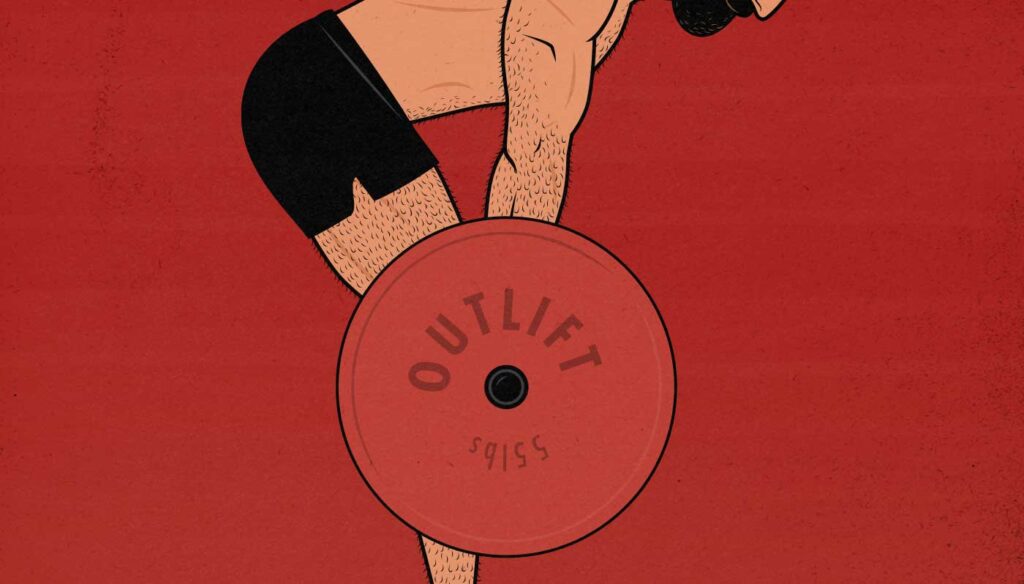
The Romanian Deadlift (RDL) Guide
The Romanian deadlift, also known as the RDL or stiff-leg deadlift, is a deadlift variation that’s used in hypertrophy training to pack muscle onto the hips and hamstrings.
So, what is it, how do we do it, how does it compare against the conventional deadlift, and why is it so popular among beginners, bodybuilders, athletes, bikini models, and powerlifters?
- What is a Romanian Deadlift (RDL)?
- Muscles Worked by the Romanian Deadlift
- How to do the Romanian Deadlift (RDL)
- The Romanian Deadlift for Beginners
- The Romanian vs the Conventional Deadlift
- The Romanian vs the Stiff-Leg Deadlift
- The Stiff-Leg vs the Straight-Leg Deadlift
- The Romanian Deadlift for Building Bigger Hips & Glutes
- The 1-Legged Romanian Deadlift
- The Dumbbell Romanian Deadlift
- Should You Use Lifting Straps?
- Ideal Rep Range
- Summary
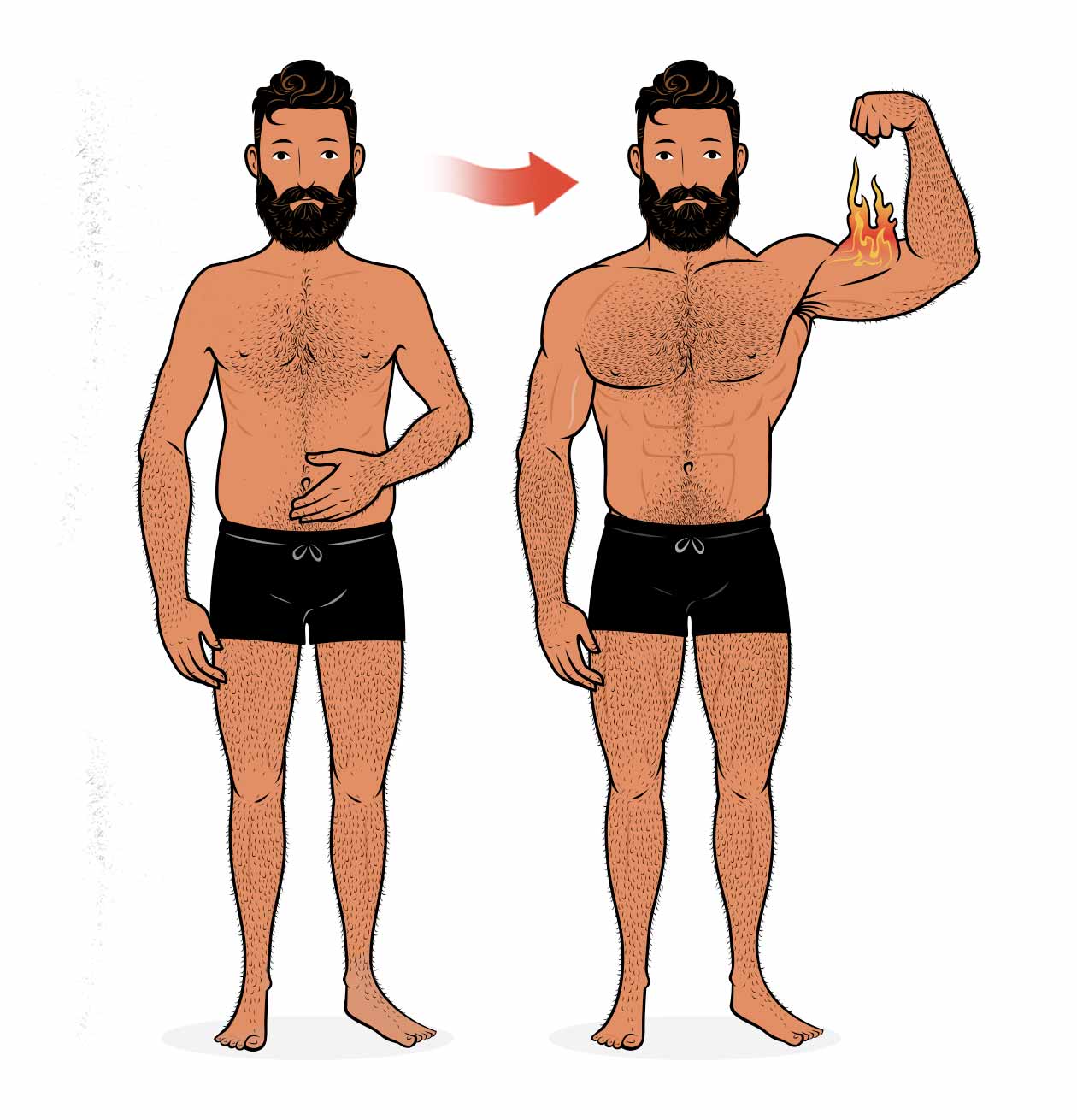
What is a Romanian Deadlift (RDL)?
The Romanian deadlift (RDL) is one of the most popular alternatives to the conventional deadlift, especially among bodybuilders. It’s a hip hinge movement where we bend at the hips and then lift the weight back up using our hips and hamstrings, like so:
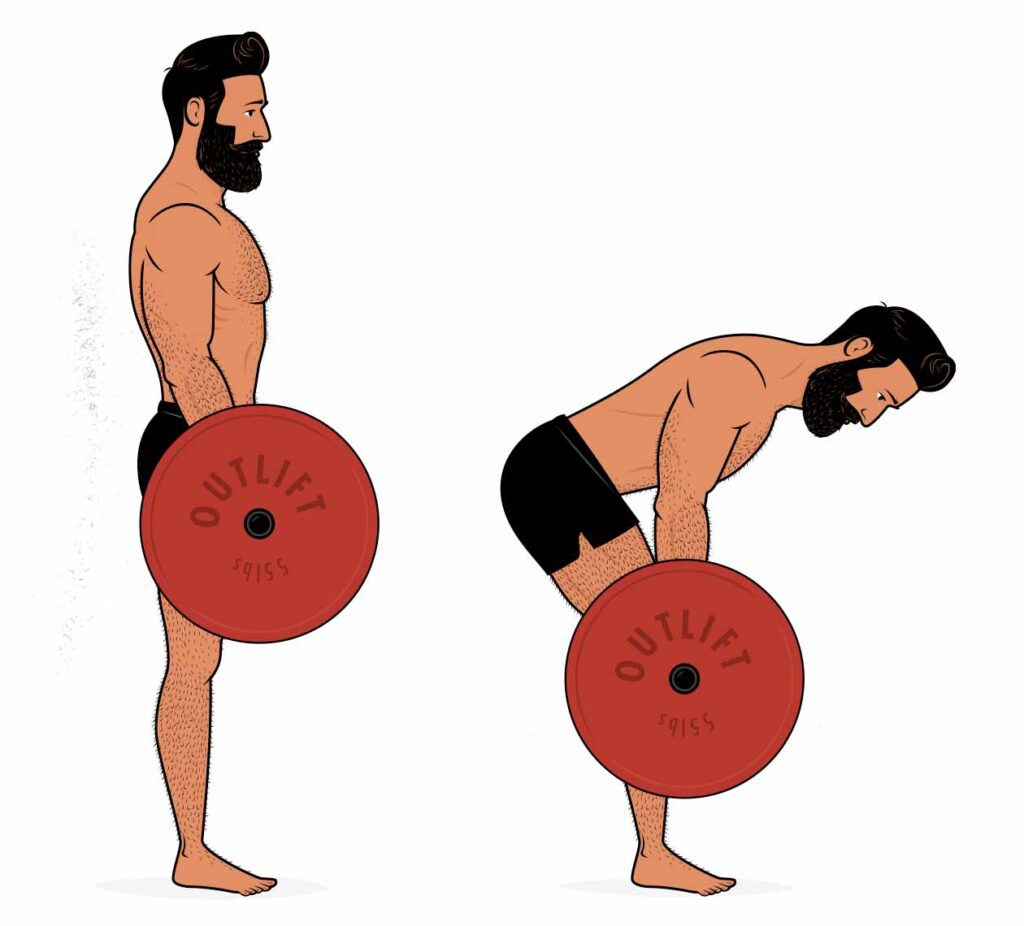
The Romanian deadlift is like the conventional deadlift, except that you start from a standing position, keep your legs stiff, and come back up when you feel a deep stretch on your hamstrings.
That gives the Romanian deadlift a few advantages:
- Keeping your legs stiff does a better job of working your hamstrings.
- Starting from the top position demands less mobility.
- The shorter range of motion is easier your the lower back.
It’s a great variation for beginners. It’s also a great lift for helping more advanced lifters emphasize hip and glute growth, making it popular with women. And because it causes less lower-back fatigue, it’s a good lift for people with cranky backs.
Muscles Worked by the Romanian Deadlift
At a glance, the Romanian deadlift works the same muscles as the conventional deadlift. The hips and hamstrings are the prime movers, but we also need to hold the barbell in our hands, stabilize it with our spinal erectors and traps, and pull it in close with our lats and rear delts. As a result, the Romanian deadlift appears to be one of the biggest compound lifts:
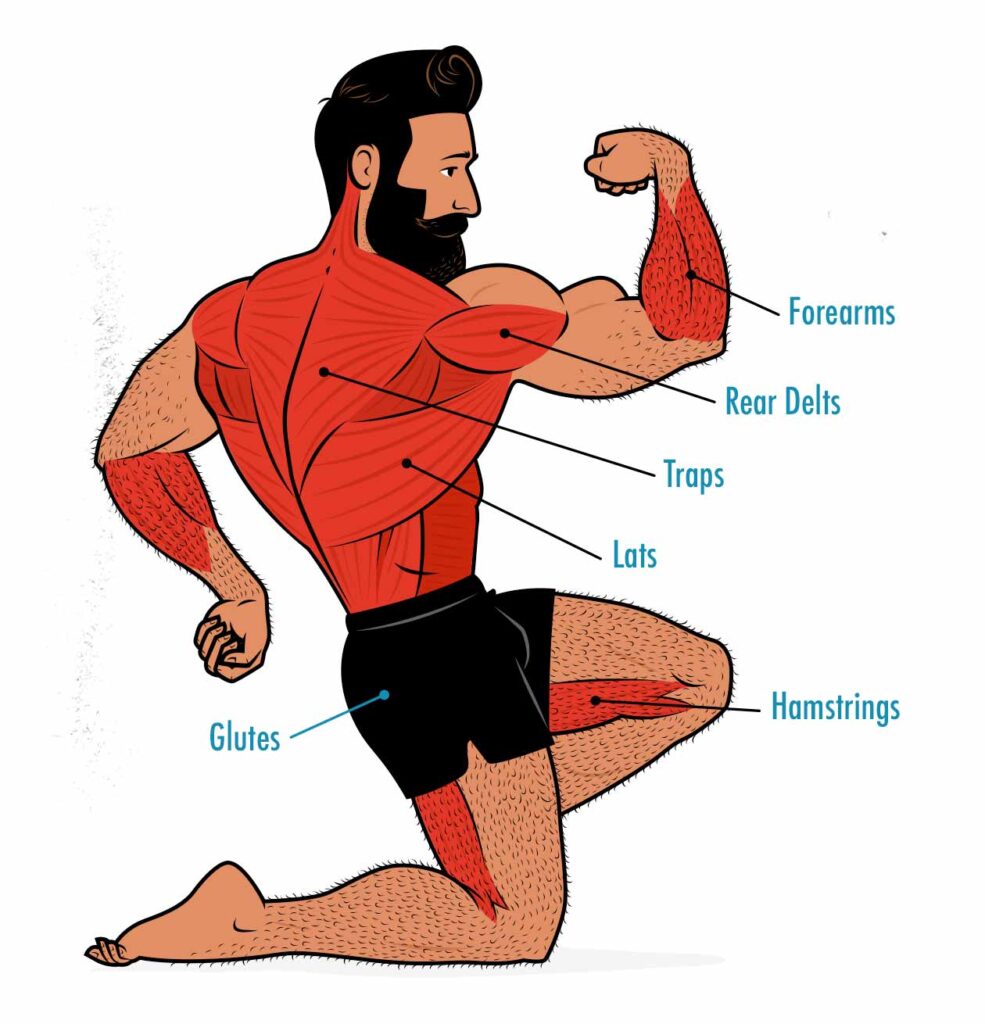
However, the conventional deadlift tends to be a fair bit heavier than the RDL. With the conventional deadlift, we bring our hips close to the bar, improving our leverage, and we bend our knees at the bottom, allowing our quads to help push the weight up. That means more weight in our hands, more weight supported by our spinal erectors and traps, and more weight to pull with our lats and rear delts.
So although the Romanian deadlift technically works the same muscles as the conventional deadlift, it places quite a bit more emphasis on the hips, glutes, and hamstrings than on the upper back.
How to do the Romanian Deadlift (RDL)
The Romanian deadlift starts in a standing position. From there, you drive your hips back, letting your knees bend as much as needed but keeping them fairly stiff. When you feel a maximal stretch on your hamstrings—probably when the barbell is just below your knees—thrust your hips forward to drive the weight back up. Here’s Marco teaching the lift:
Here are some extra RDL pointers to keep in mind:
- Set up with your feet about hip-width apart, toes pointing more or less straight ahead. This position should feel sturdy and athletic, similar to the position you’d jump from, so go a little wider or narrower if you prefer.
- Lift the barbell into position, either by deadlifting it from the floor or picking it up from a rack. The Romanian deadlift starts from a standing position.
- Drive your butt back, hinging at the hips, and don’t think of bending your knees. Your knees can bend as they need to but don’t bend them on purpose. Remember that this is a stiff-leg deadlift.
- Let the barbell drift down your body, keeping it close. In fact, you may wish to activate your lats by pulling the barbell towards your body.
- Keep your shins vertical. If they drift forward, the barbell will need to move around them, and you’ll know you need to keep them more vertical next time.
- Lower the weight slowly and under control. The barbell will glide down your thighs and past your knees.
- When your hamstrings are maximally stretched, drive the weight back up. As you lower the weight, think about loading your hamstrings like you’d stretch an elastic. Then, once your hamstrings are fully stretched, think about thrusting your hips forward, lifting the weight with your glutes and hamstrings.
- Then lower the weight back down for your next rep.
You don’t need to keep all of this in mind every time you practice the Romanian deadlift. Often, it’s better to watch the tutorial video and then give it a try, letting your instinct guide you. Then check back afterwards and see if there’s anything you can improve upon.
The Romanian Deadlift for Beginners
The Romanian deadlift (RDL) is a movement pattern called a “hip hinge,” where we bend at the hips while bracing our cores, keeping our spines locked in a neutral position. It’s a simple enough lift in theory, but when most beginners try it for the first time, it comes out looking something like this:
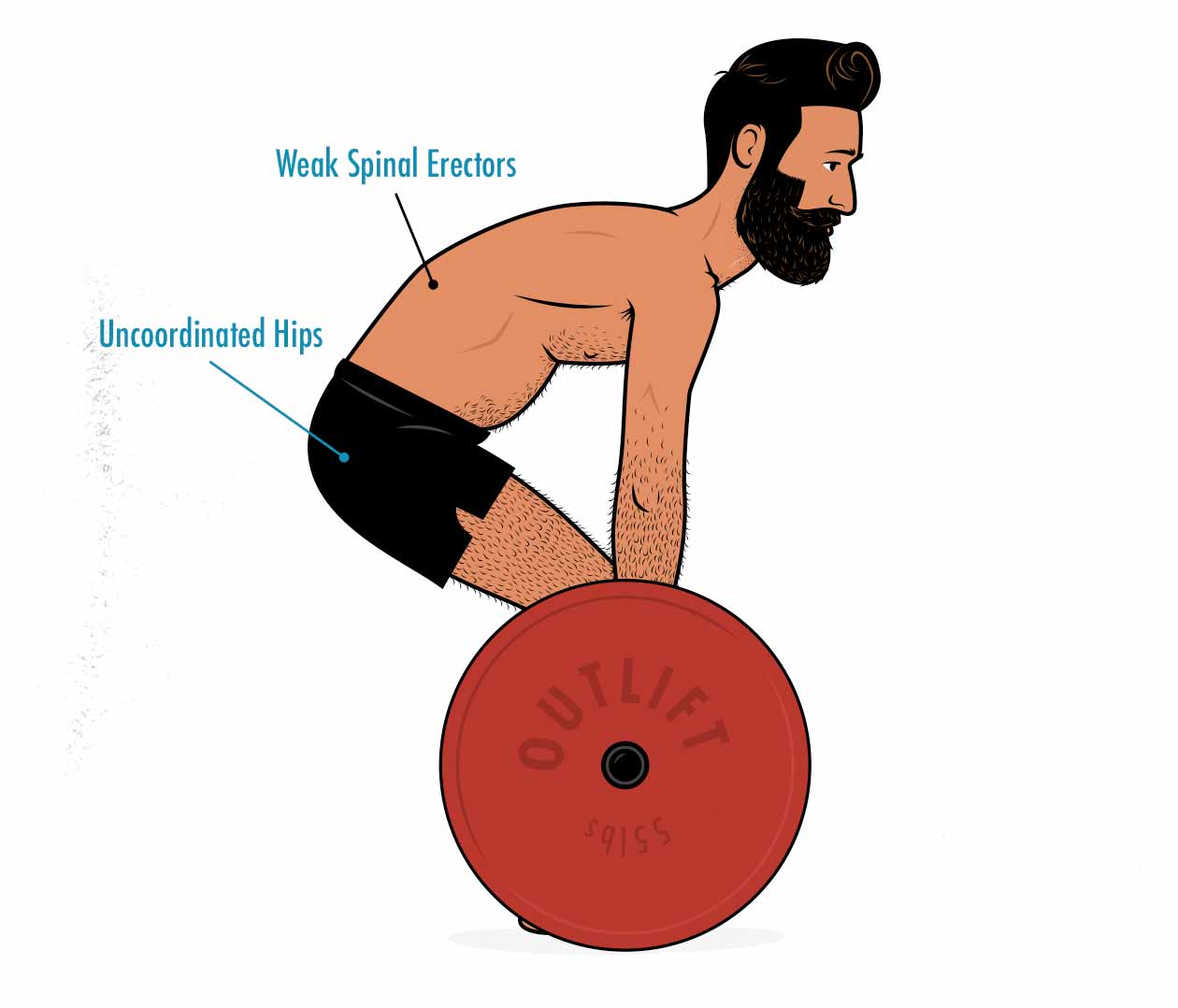
What’s happening here is that beginners often have a hard time bending at the hips without bending in the lower back, so when they’re asked to bend down and pick up a barbell, they bend in both places, like a slinky instead of a nutcracker. Even when coached to hold their chests up and keep their spine in a neutral position, it can be really hard to flex the glutes and hamstrings while keeping the spinal erectors neutral.
Plus, a lot of beginners have weaker spinal erectors, meaning that even if their coordination is good, they might not have the back strength to maintain a good back position as they lift the weight up. Worse, because rounding the back shortens the moment arm for our hips, making us stronger, like so:
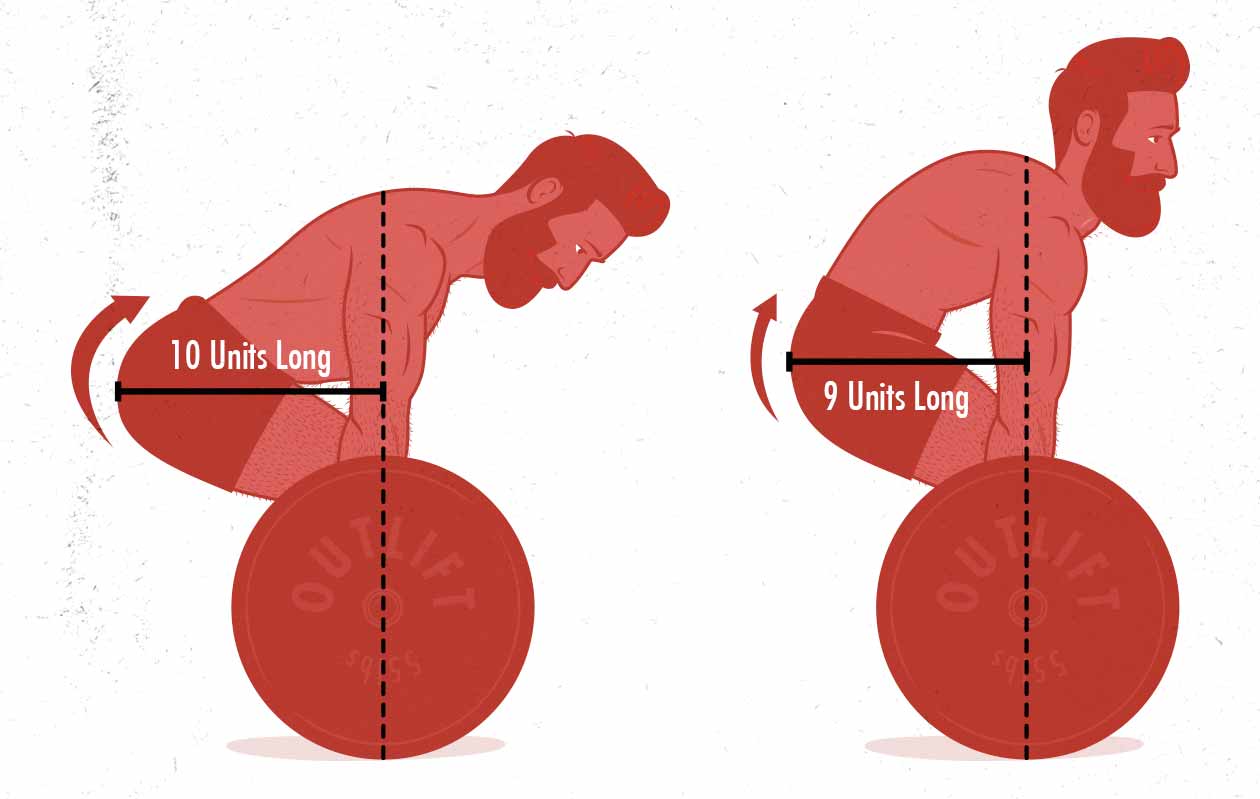
That means that when a beginner gets close to his limit, even if his spinal erectors aren’t his limiting factor, his lower back will often still bend.
Now, why is it a problem to lift with a rounded back? The problem is that the further our spine bends, the more shear stress we inflict upon it. According to the leading spinal health expert, Dr. Stuart McGill, deadlifting with a rounded back puts around 950% as much shear stress on our spines. Some people get away with it, but if we want to keep our risk of injury low, it’s better to learn how to do your deadlifts with a neutral spine.
Finally, the deadlift requires quite a lot of hip mobility. Many beginners can’t bend deep enough at the hips to get into the starting position without needing to round their lower backs. Some advanced lifters can’t even do it.
That’s where the Romanian deadlift comes in. It simplifies the movement, removing the knee bend and focusing just on the hip hinge. RDLs also start in a standing position, where it’s easier to set up with a strong posture. Most beginners find it easier to feel their glutes and hamstrings stretching out as they lower the weight, then contracting as they lift it. And the range of motion is determined by how flexible you are, not by the floor.
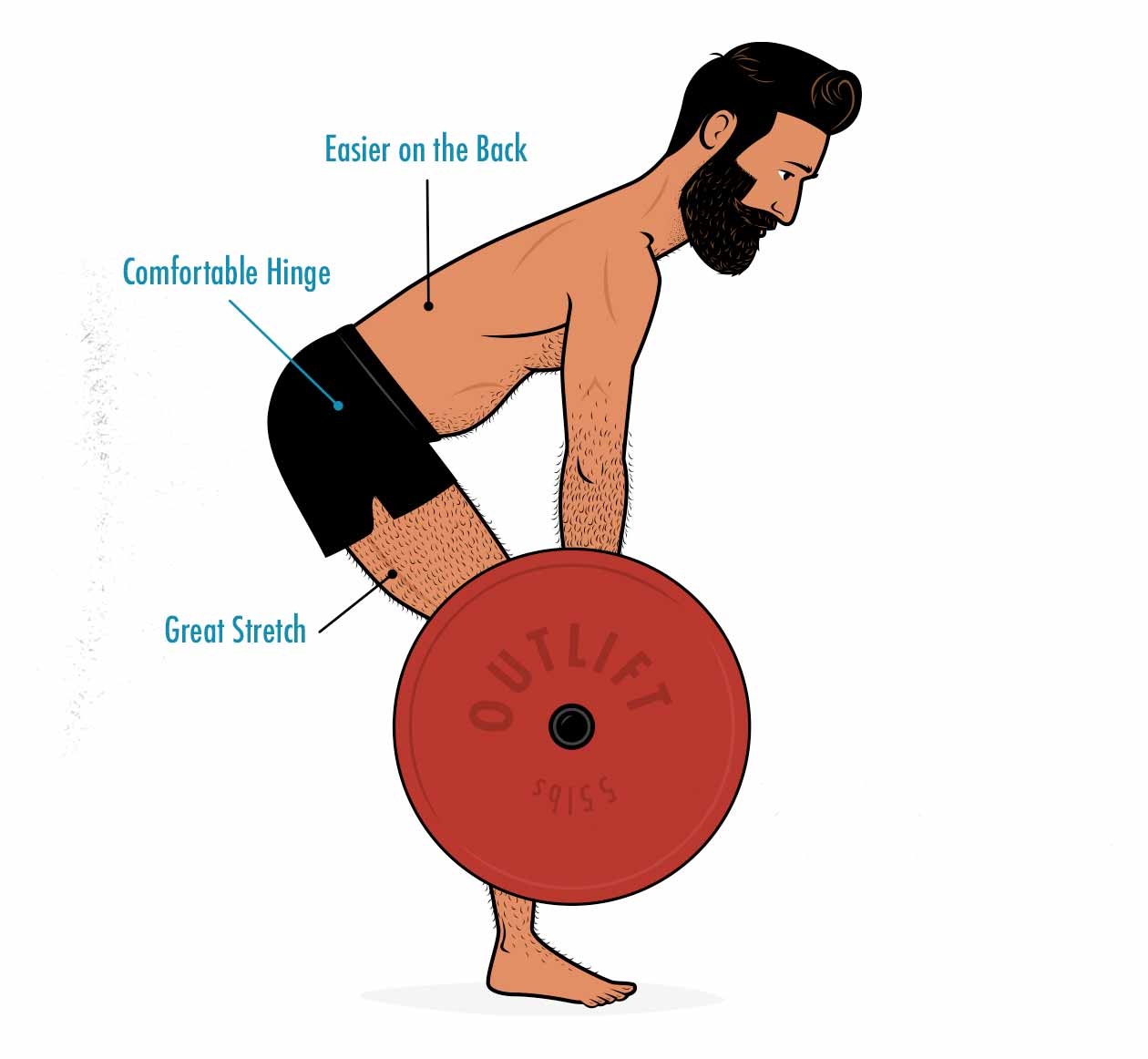
RDLs are also lighter, which can make it easier to hold onto the barbell without dropping it. And there’s also less stress on the lower back, making it less likely that beginners will be limited by the strength of their spinal erectors, and less likely that they’ll accrue so much muscle damage in their spinal erectors that they have a hard time doing their other exercises (such as squats).
Overall, the Romanian deadlift is one of the best beginner deadlift variations. It’s easier to learn, easier on the lower back, quite a bit less fatiguing, and just as good at stimulating muscle growth in the hips and hamstrings.
The Romanian vs the Conventional Deadlift
The Romanian deadlift and the conventional deadlift are more similar than they are different, and they can often serve as good alternatives for one another, depending on the situation.
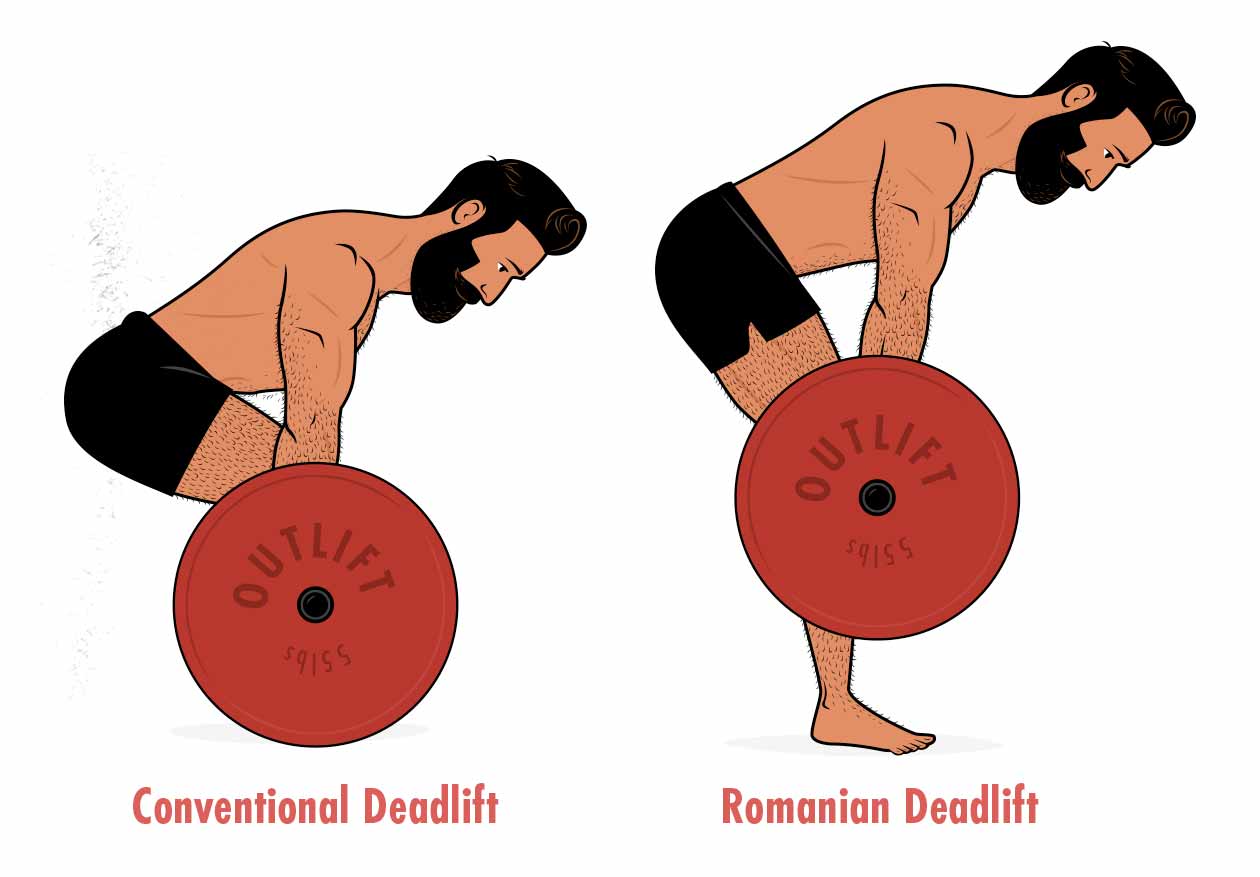
There are a few differences between the RDL and the conventional deadlift:
- The Romanian deadlift is easier to learn. RDLs start from a standing position, which can make it easier to maintain proper posture when performing the lift.
- The Romanian deadlift requires less hip mobility. RDLs are done to whatever depth you can manage, giving a good stretch on the hips and hamstrings. The conventional deadlift has an arbitrary depth—the floor—which may or may not line up with your mobility.
- The Romanian deadlift demands less of our upper bodies. When doing RDLs, we drive our hips back, allowing us to emphasize glute and hamstring growth without as much upper-body strain. When doing a conventional deadlift, we keep our hips as close to the bar as possible, improving our leverage and allowing us to lift more weight, demanding more of our spinal erectors, upper backs, and forearms. This makes the conventional deadlift the better upper-body lift.
- The Romanian deadlift doesn’t work the quads. With the conventional deadlift, we bend our knees at the bottom of the lift, allowing us to engage our quads at the expense of our hamstrings. This means that the conventional deadlift engages more overall muscle mass in the legs, but the RDL is better for isolating the hamstrings.
- The Romanian deadlift is easier on our lower backs. With the Romanian deadlift, only the very bottom of the range of motion has us with our backs in a more horizontal position, making it easier on our lower backs. With the conventional deadlift, the entire bottom half of the range of motion loads our lower backs fairly maximally, making it better for building a thicker back.
- The Romanian deadlift is done with a bodybuilding lifting tempo. With the Romanian deadlift, most people lower the weight down slowly and under control. With the conventional deadlift, it’s more popular to drop the weight back down after lifting it. But if you’re deadlifting for muscle growth, it’s better to lower it back down slowly whichever variation you’re doing.
- The Romanian deadlift keeps constant tension on the hips and hamstrings. When doing the Romanian deadlift, most people keep constant tension on their hips and hamstrings throughout the set, whereas with the conventional deadlift, they’ll often pause and reset between reps. But if you’re deadlifting for muscle growth, it’s better to keep constant tension on your muscles whichever deadlift variation you’re using.
Overall, the Romanian deadlift is easier on the lower back, less fatiguing, arguably better for bulking up the hips and hamstrings, but not quite as good for developing upper-body size and strength.
The Romanian vs the Stiff-Leg Deadlift
The Romanian deadlift (RDL) is well-known for starting in the top position, whereas the stiff-leg deadlift is a bit more ambiguous. Most strength coaches agree that the Romanian deadlift and the stiff-leg deadlift are two different names for the same lift. They may have different origins, and may have been performed differently in the past, but in modern usage, both the stiff-leg deadlift and the Romanian deadlift tend to refer to the same lift.
You can call the lift by whichever name you prefer. However, if you decide to call it the stiff-leg deadlift, keep in mind that some people might not know whether the barbell is starting on the floor or not. If you call it the Romanian deadlift, though, you’re unlikely to confuse anybody.
The Stiff-Leg vs the Straight-Leg Deadlift
The Romanian/stiff-leg deadlift starts from a standing position, the hips are driven back until the hamstrings are under a full stretch, and then the weight is lifted back up. It’s a great lift for stimulating muscle growth in the hips without tiring out the lower back.
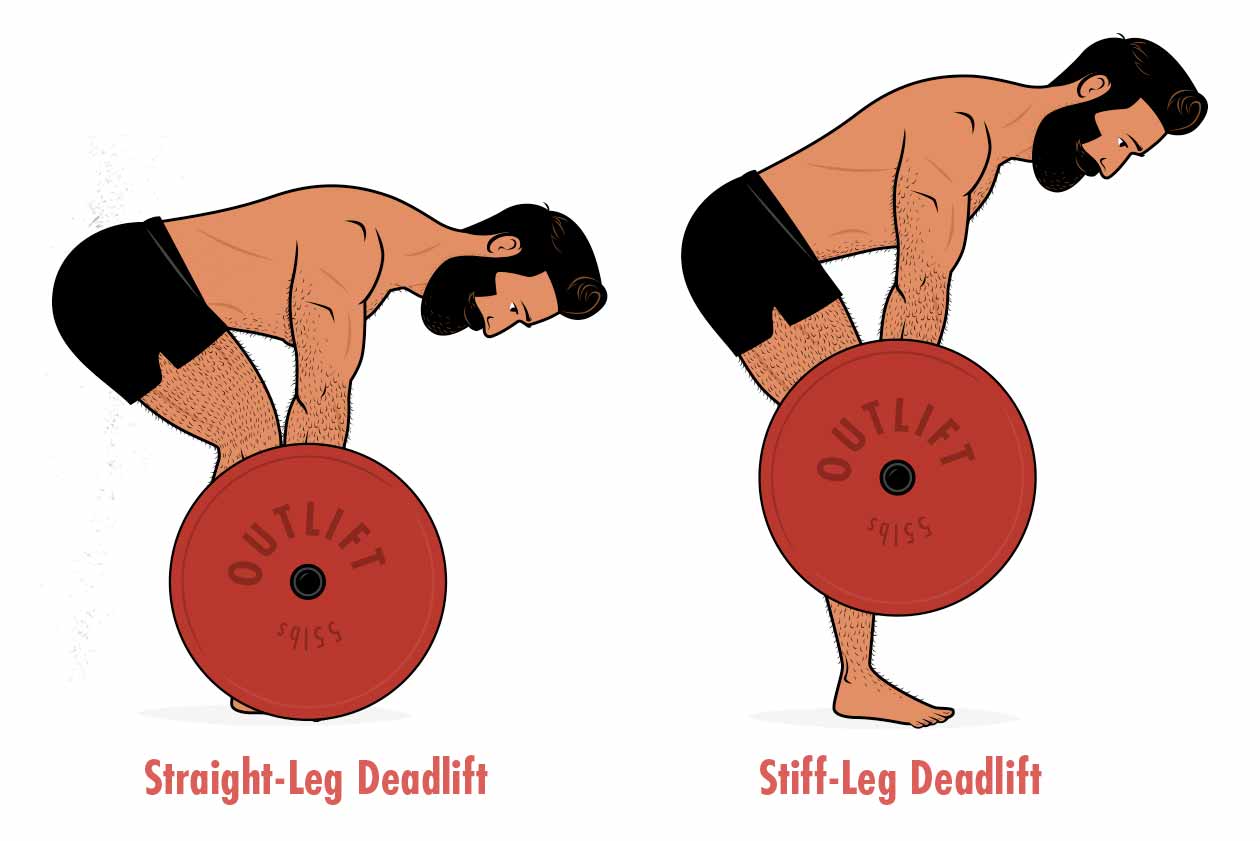
There’s some ambiguity about what a straight-leg deadlift is, but according to most strength coaches, it starts from the floor. This makes it a sort of high-hipped conventional deadlift, where the legs are intentionally kept straighter, helping to keep the tension on the hips and hamstrings all throughout the lift.
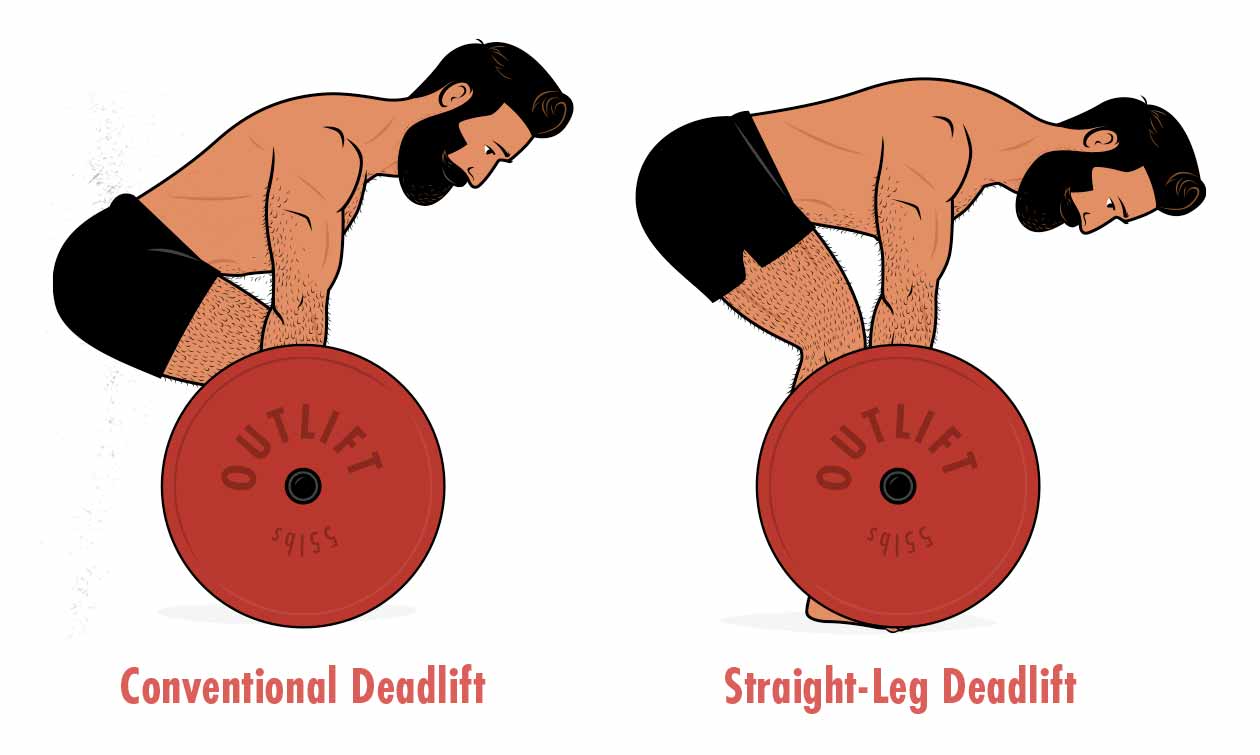
The side-effect of starting a straight-legged deadlift on the floor is that we wind up with a much steeper back angle, requiring much greater hip mobility, and also putting a ton of strain on the lower back. Now, it’s not necessarily a bad thing to stress the lower back. After all, that’s how we make it bigger, stronger, and tougher. But the conventional deadlift does a great job of strengthening the lower back while also stimulating a ton of overall muscle mass, which tends to make it the better deadlift variation.
The Romanian deadlift tends to be the better lift for emphasizing hip growth, whereas the conventional deadlift tends to be better for developing overall muscle size and strength. We don’t normally program the straight-leg deadlift because it’s needlessly hard on the lower back.
The Romanian Deadlift for Building Bigger Hips & Glutes
Of all the lifts out there, the Romanian deadlift is one of the very best for emphasizing growth in the hips and hamstrings. For powerlifters, that’s essential because it helps to improve strength on low-bar squat and deadlift. For bodybuilders, it’s a great lift for gaining muscle size. And for women who are looking to pack more muscle onto their hips and glutes, the Romanian deadlift is one of the very best ways to do that.
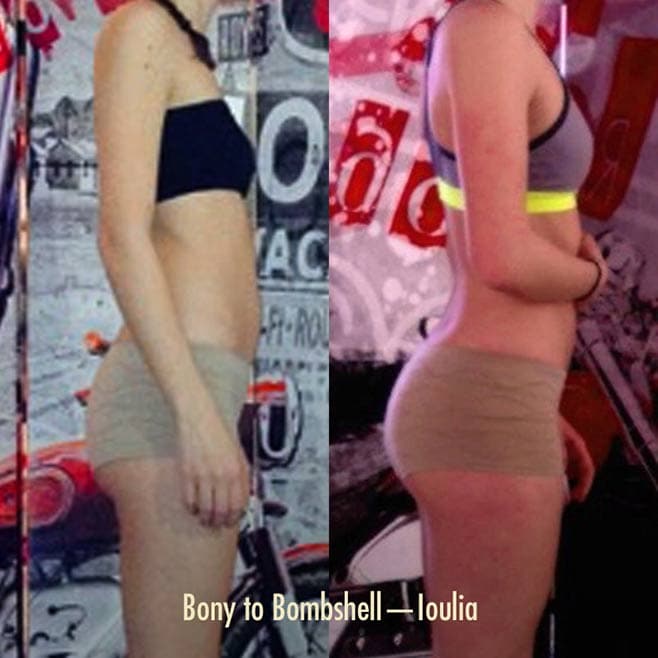
There are a few lifts that are great for emphasizing glute growth, all with their own pros and cons. The glute bridge and hip thrust are great for isolating the glutes, but they don’t load the glutes as heavily in a stretched position, so they may not be quite ideal for stimulating muscle growth. The good morning is great for working the glutes, too, and it does load the glutes and hamstrings in a stretched position, but our strength can be limited by our lower back muscles. And then the Romanian deadlift also brings in our traps and grips, making it a better compound lift for gaining overall muscle mass and strength, but introducing even more muscles that can be a limiting factor.
If the goal is to use the hip hinge as a pure hip exercise, the good morning might be the better option. But if the goal is to gain overall size and strength with an emphasis on the hips, then the Romanian deadlift becomes the much better lift. If your grip is a limiting factor, though, you may wish to use lifting straps so that you can push your hips harder.
The Romanian deadlift is perfect the best big compound lift for growing the hips, glutes, and hamstrings.
The 1-Legged Romanian Deadlift
The one-legged RDL is a good variation for putting more stress on our hamstrings, and less on our lower backs. Because we’re holding less weight, it’s easier for our backs to hold the weight. But because we’re only working one leg at a time, our hamstrings are still fully loaded.

Your spinal erectors still get worked, of course, but with substantially lighter weights and for twice as many sets. This may even act as a form of active recovery, allowing them to heal and adapt more quickly. The same is true for our forearms. We’re holding much less weight but for twice as many sets, which seems to be great for managing fatigue and recovery.
The Dumbbell Romanian Deadlift
To do Romanian deadlifts with a dumbbell, hold a dumbbell in one or both hands, like so:
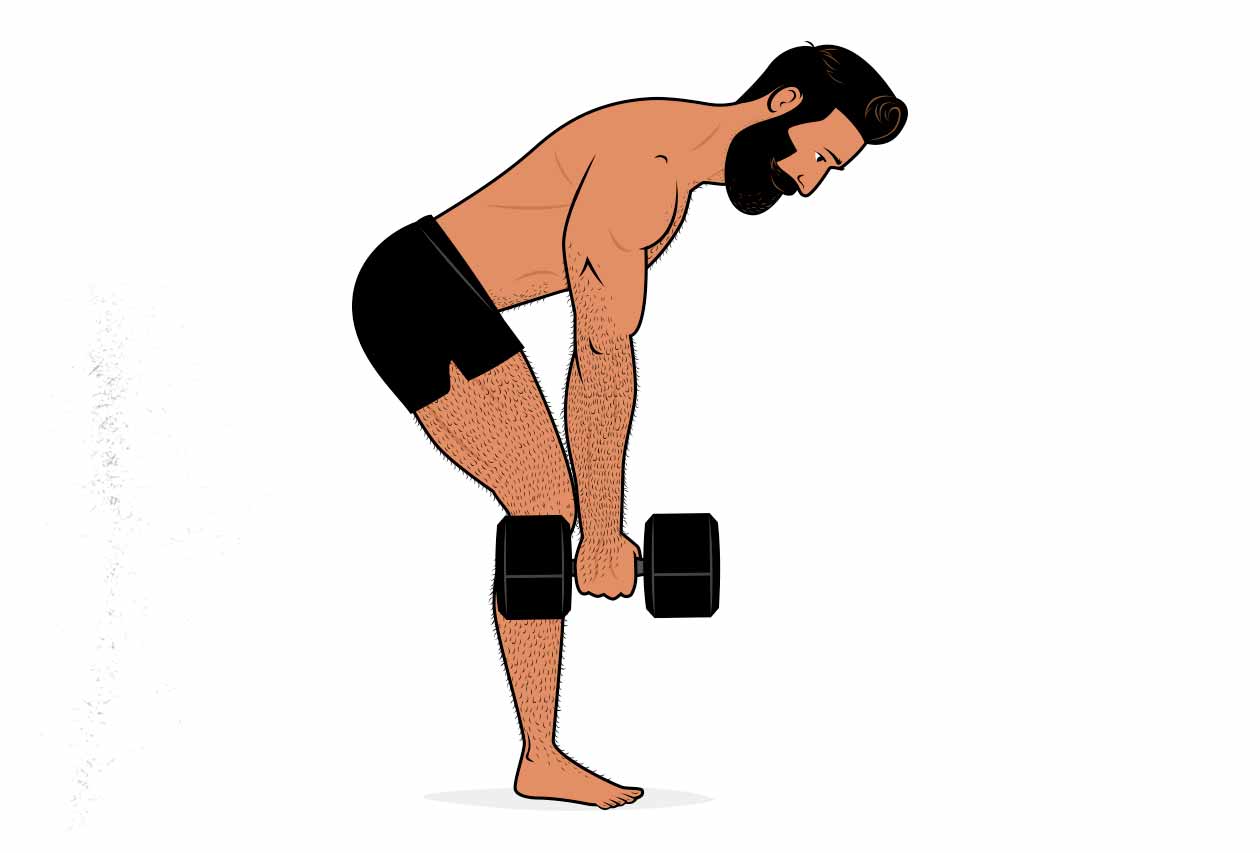
If you hold a dumbbell in each hand, you’ll do a better job challenging your hips, hamstrings, and lower back. If you hold a dumbbell in just one hand, the RDL will turn into more of an oblique exercise. Both variations can be useful, but as a default, it’s better to hold a dumbbell in each hand, keeping this a hip exercise.
The problem with dumbbell Romanian deadlifts is that unless you’re using lifting straps, your grip will often become your limiting factor, making it hard to challenge your hips and hamstrings. You can solve that by doing a single leg at a time and delving into higher rep ranges. Speaking of which…
Should You Use Lifting Straps?
As a general rule of thumb, beginners often benefit from avoiding lifting straps. But as we get stronger, our grip strength can become a limiting factor on some of the bigger compound lifts, such as barbell rows and Romanian deadlifts, turning them into little more than convoluted forearm exercises. If your grip strength is limiting you, then, it might be wise to buy some lifting straps. That way we keep the Romanian deadlift as a hip and hamstring exercise.
There are a few different types of lifting straps, and my favourite is a variation called lifting grips. They’re more comfortable, easier to use, and equally effective. We’ve got an article about how to buy lifting straps here.
Ideal Rep Range
The Romanian deadlift is a hypertrophy lift that works best in moderate rep ranges. Doing 8–20 reps per set often works well. Going much heavier can make it harder to get into the starting position, harder to maintain good technique, and can start putting more strain on the lower back. Going much lighter can make the lift too taxing on our cardiovascular systems. A good default is to start with 12 reps per set.
Summary
The Romanian deadlift, RDL, or stiff-leg deadlift, is a great compound lift for working the entire posterior chain, but it excels at emphasizing glute, hip, and hamstring growth. Not only is it great for gaining muscle size and strength, but it’s also fairly easy to recover from, fairly easy on the lower back, and one of the very best assistance lifts for the deadlift.

If you want a customizable workout program (and full guide) that builds these principles in, check out our Outlift Intermediate Bulking Program. Or, if you’re still skinny, try our Bony to Beastly (men’s) program or Bony to Bombshell (women’s) program. If you liked this article, I think you’d love our full programs.



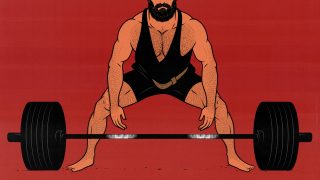
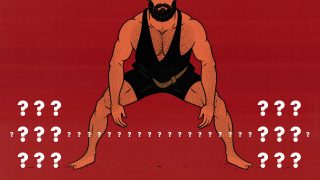

Dorian Yates was famous for the partial deadlift, aka the Romanian Deadlift.
At 49 years old I have moved away from the traditional deadlift and know do the Yates Deadlift, definitely more forgiving on the lower back.
I always do the deadlift on back day and it’s my last exercise, I find it to be a nice finish off when I’m completely exhausted.
That’s a great idea, yeah. For people who can handle it, I think the conventional deadlift is a great exercise, and a good foundation of a bulking routine. But the Romanian deadlift is just as good in most ways, and it’s quite a bit easier, quite a bit less fatiguing, and much more forgiving on the lower back, for sure. Awesome, awesome lift 🙂
Really great article, as always! Very comprehensive, very easy to follow, and very much a page-turner, where one wants to just keep reading and reading!
So, RDL is essentially the top half (maybe the top 2/3?) of the full range of motion of the Conventional Deadlift (CDL), correct?
Regarding Towel Deadlift (TDL), if one can TDL at bottom of CDL (say grip right above ankles) do you see benefit in also TDLing at bottom of RDL (say grip just below knees)?
Thank you very much.
Thank you, Fleischman 🙂
You’re right, yeah, but it’s probably better to think of the RDL as the hip extension portion of the deadlift. It works the hips and hamstrings through a full, deep range of motion. In fact, the Romanian deadlift often has a deeper range of motion on the hips and hamstrings. It’s just that we don’t bend our knees at the bottom, so we don’t bring the quads into the lift.
If you’re doing bodyweight towel deadlifts, yeah, you could set up lower with bent knees to engage more quad or set up in the stiff-leg RDL position to engage more hamstring.
Hi Shane. What I have always known and read in so many articles over time is that stiff-leg deadlift and straight leg deadlift is same thing, commonly abbreviated as SLDL, whereas RDL was named after a Romanian Olympic weightlifter who was practicing second pull of the lift in this manner hence the name Romanian Deadlift (RDL).
Moreover, stiff-leg deadlift is more appropriate name than straight leg deadlift because actually only shins are kept straight (contrary to slight knee tracking in conventional deadlift) while maintaining the same bend angle throughout the movement i.e. stiff leg position. The name straight leg deadlift gives an impression that legs are completely straight or locked with zero bend which is incorrect although one can opt for it but it shall put excessive stress on lumbar spine.
I am sharing here just two links for reference but internet is full of many other useful information on this.
Old School Labs: Stiff-Leg Deadlift vs Romanian Deadlift
Bret Contreras: What’s the Difference Between Stiff-Leg, Straight-Leg, and Romanian Deadlifts
I hear ya, Farhan. It’s trick to make sense of all the terms. To quote Contreras int aht article you linked: “Many lifters feel that the RDL, stiff legged deadlift, and straight leg deadlift are synonymous with one another, and if you talk to ten different strength coaches, you’ll probably get ten different descriptions of these variations.” That’s why we normally call it the Romanian deadlift, where almost everyone is in agreement about what it is and what it looks like.
You’ll see in that first link that the author writes about how the Romanian and stiff-leg deadlifts were historically different but are now used interchangeably. The main disagreement seems to be over which variation starts from the floor. Fortunately, nobody thinks that the Romanian deadlift starts from the floor, so that keeps us safe from being misunderstood if we talk about the RDL.
You know, I could add a paragraph about the confusion and debate, though. That might help to clarify things. I’ll do that now.
Thank you 🙂
Hello Shane,
Can you explain why Romanian Deadlift is easier on the spinal erectors/lower back than Conventional Deadlift? Don’t both have very similar degree of hip flexion?
And, is there a way to tweak the former exercise so it involves the lower back more, while still involving glutes and hamstrings?
Thank you,
F
Hey Fleischman, I’ve been thinking about that, and you’re right—both have a similar degree of hip flexion. With the Romanian deadlift, though, our hips are only fully flexed for a moment, whereas with the conventional deadlift, they’re flexed for the first half or so of the range of motion.
I think the bigger factor, though, is that most people are able to deadlift heavier weights than they can use with the Romanian deadlift.
But you make a good point, and it’s something I’ve been curious about, too.
To get more lower back work in, you could pause at the bottom of the range of motion, supporting the weight isometrically with your spinal erectors.
Hi. I do a 4-day upper-lower split routine where I train every other day (upper, rest, lower, rest, repeat).
I just started doing Romainian Deadlifts today on one of my two different lower-body workouts, and I’m already feeling minor lat soreness. So this makes me wonder…
Will Romanian deadlifts on lower-body days hinder my performance on chin-ups on upper-body days? I like both exercises and want to keep my split.
Thanks.
Hey Rob,
Yeah, deadlifts are just as much a back exercise as they are a leg exercise. Depending on your build, they may even work your back harder than your legs. That’s certainly the case for me.
Even so, it’s okay to train deadlifts on your lower-body days, and it’s okay if they interfere a little bit with your chin-ups. You’ll still be stimulating muscle growth, and the extra back volume, if anything, will help you bulk up your back even faster.
The soreness might be crippling at first, but it will soon fade. As you get used to the exercise, it won’t wreck you quite as much. You should be okay.
Plus, you’ve got a day of rest between the deadlifts and chin-ups anyway! So no problem at all.
Hi Shane,
First, your content has been super helpful to me as a guy who didn’t care about exercise at all until last year when I got a high cholesterol score! Got into weight training about 6 months ago and now it’s kind of an obsession lol.
Although I have a gym membership, I often like to alternate between gym days and exercising at home. With the home setup, I can’t really challenge myself with the RDL unless I do like 25 reps — to make the RDL more of a challenge at lower reps, would the 1-leg RDL be adequate or would I be missing out on something? For the bulgarian split squats, I load some of my weights in a backpack, but I’m not sure if that would work with the RDL..any thoughts would be much appreciated!
Thank you so much, Josh! I’m really glad it’s been helping 🙂
That was a big wake-up call for me, too. I’m not sure how familiar you are with our content, but I have familial hypercholesterolemia, which means I have a tendency towards high cholesterol and very poor blood lipids, often leading to heart disease at very young ages. I was diagnosed at eighteen, right after my dad had a nearly fatal heart attack. Even at eighteen, even though I was thin, I was already at high risk of having a heart attack.
I didn’t think of it too much at the time. I thought it was my genetic fate. But with a decade of eating well, lifting weights, gaining seventy pounds, and trying to get better sleep, I’ve managed to bring my cholesterol back within the healthy range. My cardiologist told me it was the most profound health transformation he’d ever seen. This is all to say that I think you can do it, too 🙂
One-legged “kickstand” RDLs (where you use your second leg for balance) are great for building bigger hamstrings. The main difference is that you won’t be challenging your spinal erectors nearly as much. You won’t be loading your skeleton as heavy, either. It’s more of a hamstring isolation exercise, less of a full-body posterior chain exercise. That isn’t necessarily a bad thing, especially if you have other exercises that make up for it. And besides, it might still be heavy enough to build your posterior chain as strong as you ever need it for daily living.
The backpack idea is interesting. Give it a try! See how it goes. I can imagine it working, but I haven’t tried it. I’m not sure.
Thanks, Shane! Appreciate the thorough response (and what looks like many thorough responses to commenters).
I’m gonna try loading weight with a backpack for RDLs soon and see how that goes–I guess the main thing will be to continue to keep my spine straight despite the pressure. . Going to also try out the one-legged RDLs. I started on RDLs pretty recently but they’re quickly becoming one of my favorite lower body exercises, along with the brutal Bulgarian Split Squats.
I didn’t realize you dealt with high cholesterol — sounds more extreme than my situation, but I’m shocked at how much nutrition and exercise effects my LDL…last time I tested I was within a normal range and no need for statins.
In any case, I really appreciate the response and if I ever go in on a program, I’ll know where to look!
That’s great, man. Congratulations on improving your LDL. That’s so cool 🙂
While doing this exercise, if you keep the entire length of the leg straight as opposed to just keeping them straight from the knees down, will it stretch the hamstrings even more?
Like how this dude is doing it here⬇️
https://www.instagram.com/reel/C_DznSpojOf/?igsh=MW91Y3BqcGVwbGk3bA==
I would call that more of a straight-legged deadlift, which is a more extreme version of a stiff-legged “Romanian” deadlift. I’m not sure it matters what they’re called, though. Different people call them different things.
When doing Romanian deadlifts, you’re keeping your knees stiff. That’s the stiff part. But that doesn’t mean you need to keep them completely immobile. It’s okay if they bend a little bit, naturally, to allow you to lift more weight more athletically.
It isn’t wrong to keep your legs straighter, but it will become a smaller isolation exercise. I suspect it will do a similarly good job of working your hamstrings while working your glutes less hard. Depending on how deep you go, it might also be easier on your lower back, maybe.
The guy in that video is going very deep, finishing the range of motion by bending his lower back. It’s sort of a straight-legged deadlift combined with a Jefferson curl. That isn’t wrong, either. It’s okay to work the spine with light weights through a range of motion. He’s using very light weights, so I wouldn’t expect a problem.
He’s lifting 12-kilo dumbbells, right? So 24 kilos? Someone that size would usually be doing Romanian deadlifts with around 160 kilos. Maybe more. That changes things quite a bit.